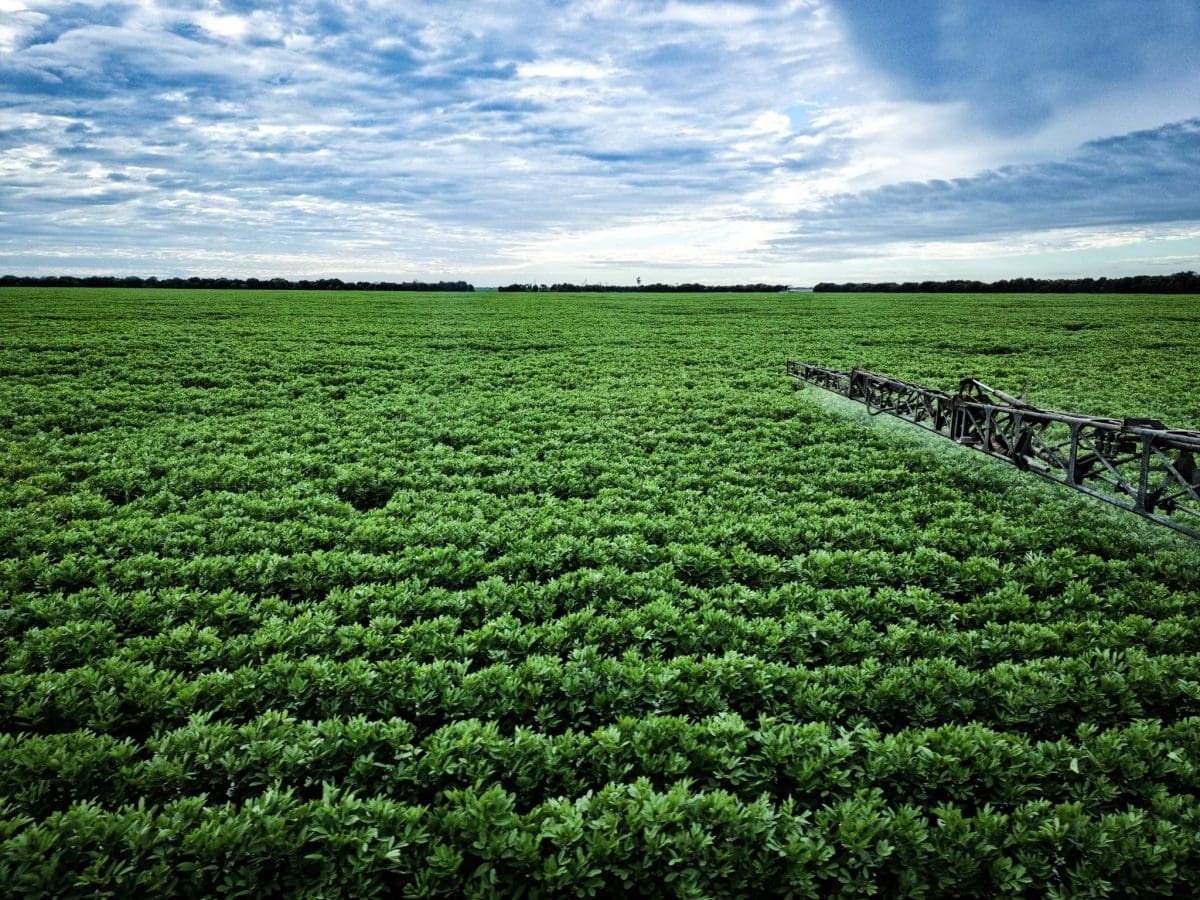
Confederation of All Indian Traders pulses and food grain committee chair Pradeep Jindal (centre) and his peers lobby Piyush Goyal, India’s Minister of Consumer Affairs, Food and Public Distribution and Commerce and Industry last week over India’s recent implementation of stock limits on pulse importers. Photo: Supplied
AUSTRALIA’S winter pulse crops are powering ahead in mostly good to ideal conditions while export business slows to a crawl as global traders assess the impact of Canada’s drought on global pulse supplies, and India’s stock situation.
The Indian Government early this month imposed stock limits on its pulse wholesalers of 200 tonnes per business in the hope that their sell-down will reduce India’s domestic retail prices.
Today that limit was increased to 500t.
Traders in India as well as Australia and Canada are concerned this policy will run down India’s stocks of pulses to critically low levels, and spark an overnight call for imports.
Grain Trend director Sanjiv Dubey said the policy dated back to the 1950s, and had not changed to reflect India’s population growth since then, nor the complexity of its market where retail chains as well as traditional outdoor markets served the Indian customers.
“Wholesalers are dealing with 38 different pulses, and a group of importers might be bringing in a cargo of 40,000-50,000t of, for example, yellow peas from Canada.
“A lot of representation to the Indian Government is going on about this at the moment.
“We understand we cannot dictate policy to India, but in the case of tariffs on chickpeas and lentils, we are saying you must give us two to three months’ notice.
“Wholesalers are saying: “Could we have some long-term policy?’ That way, no-one gets caught out.”
Prohibitive tariffs are currently in place in India which effect Australian chickpeas and Australian and Canadian lentils.
Mr Dubey said the latest development in India had therefore not had an immediate impact on prices.
India’s stock limit was introduced without warning to the market earlier this month and is expected to be in place until October 31, and the only expected pulse is believed to be moong, or mungbeans.
All prices quoted are AUD unless stated otherwise.
Chickpeas
Offers for chickpeas delivered Downs packer are sitting at around $650/t, the low point of where they were trading in mid-June.
However, bids have fallen to more like $580-$590/t.
New-crop chickpeas were last month trading in limited volume at $630/t, but bids are now $40-$50/t below that.
Australian Grain Export pulse trader Will Alexander said the surfeit of Australian chickpeas currently in Pakistan was largely behind the current-crop drop.
“Pakistan ground to a halt last month, and the market’s down $50-$60,” Mr Alexander said.
Mr Dubey said the chickpea market was falling, and had nearby offers but no buyers.
“Pakistan doesn’t want to buy any more, and there is no confidence coming out for India.”
Trade sources report containerised freight rates are now double or triple where they were a year or two ago, and container trade is slow, difficult and expensive.
Shipment time from Australia to Pakistan is taking up to 10-12 weeks, roughly three times longer than normal, as the number of shipping lines servicing South Asia contracts.
“We’re almost in August, and normally you start selling new-crop chickpeas in February.
“It’s the uncertainty of shipping and of markets, particularly India, that has made things so quiet.
“Instead of India’s tariffs going down, there are stock limits instead.
“This is the lowest amount of business in new-crop I’ve done in chickpeas, and I’ve been doing it for 20 years.”
On the production front, crops in southern Queensland and northern New South Wales are enjoying an ideal season, if a little too wet in places.
The Central Queensland season is patchy, but is expected to produce enough to fill a couple of cargoes or part cargoes for September-October shipment, with Bangladesh the likely customer.
Faba beans
Prices for faba beans have fallen $35/t or so in the past month to around $340/t delivered up-country packer, and $355-$360 delivered Melbourne and Adelaide packers.
Volume traded remains thin as bulk business appears to have stopped for the current year once, with only 20,000t ex South Australia pencilled in for next month ahead of new crop.
Shipping stems indicate Australia has exported a record 400,000t from its record 2020-21 crop of 510,000t.
Agri-Oz managing director François Darcas said there was “hardly any market” for current-crop fabas, and growers were unenthused by current bids.
“There is very limited export demand, and prices are too low to attract selling,” Mr Darcas said.
“Feed buyers still paying the best prices, but they are not buying enough to take care of the carry-out.”
Another big Australian faba bean crop is on its way, but Mr Darcas doubts it will match 2020-21 production.
“I think new crop will be smaller than 2020-21.
“There is probably a drop in area sown because of high canola prices and late rains in Vic-SA and we would need a perfect spring again for very good yields.”
Baltic and UK faba beans can be expected to hit export channels in coming months, and any adverse weather like the recent flooding in Germany could tighten the market.
New-crop fabas are yet to start trading, but some bids at around $375-$380 delivered port are popping up.

A faba bean crop is sprayed earlier this month as the season brings welcome rain which also ups the ante on growers to control weeds and fungal outbreaks. Photo: Jake Hamilton, Condamine, Qld.
Lentils
The market for current-crop lentils has been steady over the past month at around $800-$820/t delivered up-country packer, and the new-crop market is indicating it will kick off at similar levels.
Mr Alexander said both markets were fixed on the Canadian crop.
“Everyone’s watching Canada; it’s getting hot and dry there.
“Being the biggest exporter of red lentils in the world, it’s weather will have a huge impact here.
Mr Alexander said the historically high prices already on offer were attracting a limited amount of forward selling from growers ahead of the earliest new crop becoming available in November.
On the production front, recent rain in South Australia and Victoria has improved prospects for crops which were running low on sub-soil moisture.
However, the crop will need a kind spring to finish well.
Mungbeans
Prices for mungbeans have eased in the past month as final tonnages for the 2021 harvest hit the market.
China and Vietnam have been the volume buyers of the crop, with manufacturing-grade mungbeans most recently trading at $1000-$1050/t delivered Downs packer.
This is down $50-$100/t from last month’s levels.
At Dalby, Deacon Seeds general manager Mark Schmidt said rain in March which added yield to crops adversely affected quality, and grading losses accounted for maybe 15-20pc of the later crop.
This contrasts with last year, when unusually high quality saw grading losses of less than 10pc.
“Most of the product was manufacturing quality, and the prices have held up reasonably firm considering.”
Mr Schmidt said Downs mungbean packers had had some added pressure due to limited availability of containers ex Port of Brisbane
“We haven’t lost any days of packing, but we’ve gone close.”
He said in some cases, containers were being released from portside container parks two days before the sailing cut-off.
“If we miss that vessel, we mightn’t get a space for two weeks.”
Industry estimates say the 2020-21 mungbean crop was around 90,000t, roughly 50pc bigger than last year’s due mostly to yield-boosting rain in autumn.
“When it was planted, we thought it might be a 150,000t crop, and then when it turned dry, it could have been 30,000-40,000t.”
“It responded well to the rain, and to good management from the grower.”
Grain Central: Get our free cropping news straight to your inbox – Click here

good article thanks for the article
When discussing pulses markets can you include other pulse crops as well such as lupins, and fieldpeas and any others that are grown in Australia on a commercial basis. These market reports are like a half done school homework assignment